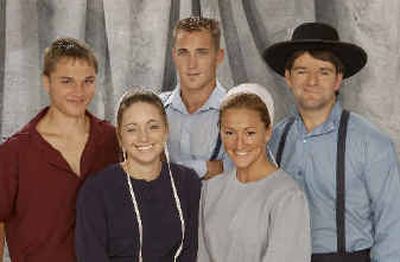Breaking tradition

Television is not part of the traditional Amish world. But the Amish are now part of television, like it or not.
“Amish in the City,” a new UPN reality series, gives five young adults the chance to explore the big city and discover what life is like outside their traditional communities.
In the first two episodes, they hit the beach for sun and fun, visit a mall and cultivate sometimes uneasy relationships with six non-Amish sharing their temporary Hollywood Hills home.
Compared to other fishbowl shows like “Big Brother” or “The Real World” the series is tame, at least in the early going. There’s no drinking, no sex and no knife-wielding roommates in the two-hour premiere that airs Wednesday at 8 p.m. (cable channel 24 in Spokane, 16 in Coeur d’Alene).
But there are bikinis, they’re scanty and they’re worn by the Amish women.
“Oh, my, really?” said Amish cultural historian Joseph Yoder after hearing a description of the program.
Not something they typically wear?
“Heavens, no, not in public,” he replied.
Yoder is concerned the series will live down to his expectations and justify the protests he lodged as director of Menno-Hof, an Amish and Mennonite center in Shipshewana, Ind.
“Our concerns were that Hollywood would probably get it wrong with the Amish, and just the whole thing of televising the Amish and putting Amish people on TV,” Yoder said. “(The Amish) don’t even believe in this kind of thing; they’re trying to stay separated from the world.”
Not the two women and three men from Midwestern Amish communities featured on the series, which is billed by its producers as a coming-of-age saga. They include (identified only by first names) Jonas, an Iowa native; Miriam and Ruth, both of Ohio; Mose, of Wisconsin; and Randy, of Indiana. All are between 18 and 24.
Members of the Amish community, a Christian sect concentrated in rural Pennsylvania, Indiana and Ohio, are known for simple attire and avoiding most technology. But at age 16 they’re allowed to break free of their strict code before deciding whether they want to be baptized as adults.
During the period of “rumspringa,” a Pennsylvania Dutch term that means “running around,” youths often date, drink, drive cars and move away from home. Most then return to the faith.
Most don’t roam as far as Los Angeles and have their adventures filmed by a TV network. But the series’ intent is not to typecast or offend the Amish, said one producer, Daniel Laikind.
“We certainly went in with an attitude that this was about the individual people and individual journeys that were going on,” Laikind said. “We’re not trying to say the five participants who grew up Amish are representative of every Amish person in existence.”
He and Steven Cantor produced an acclaimed documentary about Amish teenagers, “Devil’s Playground.” Laikind, Cantor and Jon Kroll (“Big Brother,” “The Amazing Race”) are executive producers on the TV show.
UPN, which quietly pursued the program despite criticism, defends the result.
Network entertainment chief Dawn Ostroff pronounced “Amish in the City” of “great quality” before screening the initial episodes for the Television Critics Association last Tuesday. “We learn a lot about human nature,” she said.
For the Amish, exposure to the sights and sounds of urban California life is mostly exhilarating to young people who have lived without electricity and other modern elements.
“If I’m going to go out and explore, I’m going to go all the way,” says Mose after putting on a hip new wardrobe picked out by the “city kids,” the non-Amish roommates.
Ruth marvels at paintings in a gallery; such art, she says, isn’t part of Amish life. Even the most mundane aspects of the city, including parking meters, can stop the L.A. newcomers in their tracks.
The challenge to their emotional and religious core isn’t ignored. After a perilous first attempt at ocean swimming, the already baptized Mose fears for his soul outside the Amish community and seeks solace in the Bible.
U.S. Rep. Joe Pitts of Pennsylvania was among 51 lawmakers who signed a letter asking UPN to abandon the project.
“No matter how they do the show, the fact they’re doing it is abhorrent to the Amish,” he said, adding that advertisers should “think twice about lending their name to a show that might be degrading to a minority group.”
Pitts’ request for an early screening was rejected by UPN, as was that of a UPN affiliate in Pennsylvania that said it worried the show could be exploitative.
“I don’t want to be judged by a member of Congress before the show goes on the air,” said Leslie Moonves, a top executive with UPN parent company Viacom.
The impact on the Amish won’t be lasting, predicted Yoder, who’s Mennonite. (The Amish separated from the Mennonites in the 17th century.)
“The Amish will survive this,” said Yoder. “They’re a strong Christian community and a few kids going astray and being lured by big money aren’t going to ruin them. But it will give (viewers) a very false perception.”